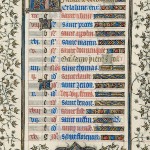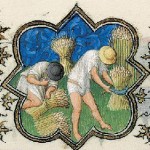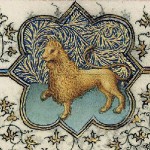Posts Tagged ‘grain’
Friday, March 11, 2011
At certain times of the year in the medieval rural landscape, it would have been common to see plump sheaves of grain standing in sunny fields like so many golden tokens of agricultural wealth and prosperity, as numerous depictions???even in some of the most sumptuous manuscripts of the Middle Ages, such as the Belles Heures of the duke of Berry???attest. At harvest, the wheat was cut at the base of the stalk with a sickle and then gathered up in large armfuls and tied about the middle. The resulting bundles were left spaced and standing upright in the fields, which allowed them to dry even if it happened to rain before they could carted off for threshing.
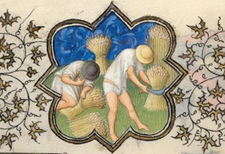

Details of illuminations from Folio 8r and Folio 9r from the Belles Heures of Jean de France, duc de Berry, 1405???1408/9.
Read more »
Tags: barley, Belles Heures, blazon, Bolton, caraway, carrot, Cheshire, Comyn, cumin, Cuminum cyminum, garb, Geoffrey Chaucer, gold, grain, Grosvenor, heraldic, heraldry, John of Gaunt, oat, Owain Glynd??r, parsley, rye, Scrope, sheaf, sheaves, shield, wheat
Posted in Plants in Medieval Art | Comments (1)
Thursday, February 10, 2011
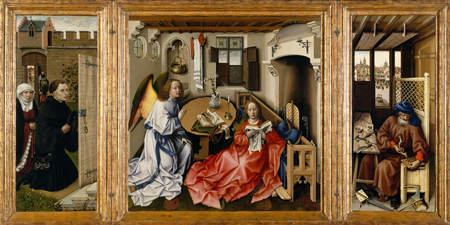
Robert Campin and Workshop (South Netherlandish, Tournai, ca. 1375???1444). Triptych with the Annunciation, known as the “Merode Altarpiece,” ca. 1427???32. Made in Tournai, South Netherlands. Oil on oak. The Metropolitan Museum of Art, New York, The Cloisters Collection, 1956 (56.70a???c). See Google Art Project for an in-depth look at this work.
A great many things have changed during the twenty years that I’ve been working at The Cloisters, but its special atmosphere remains constant. One of the most unique aspects of the Museum is the way in which the gardens are integrated into the collection. From the Museum’s inception, the curators envisioned the artwork and gardens as a whole, where the plants were not merely aesthetic elements, but also of great educational value. Many of the galleries either open directly onto or provide views into one of the three interior gardens (see floor plan). This arrangement encourages visitors to experience the gardens as part of medieval culture, to make connections between the plants and the objects, and to understand both within the historical context presented in the galleries. Read more »
Tags: Antonites, Bellis perennis, Claviceps purpurea, corn poppy, Cuxa Garden, English daisy, ergotism, fungus, Galen, grain, hermit, ignis sacer, Isenheim, mandrake, Matthias Gr??newald, monasticism, Niclaus of Haguenau, plantain, poppy, sage, Saint Anthony Abbott, Saint Anthony's Fire, Saint Vinage, Tau cross, verbena
Posted in Gardening at The Cloisters, Plants in Medieval Art | Comments (1)
Monday, July 6, 2009
Above, from left to right: Calendar page for July from the Belles Heures of Jean de France, Duc de Berry, 1405???1408/1409. Pol, Jean, and Herman de Limbourg (Franco-Netherlandish, active in France, by 1399???1416). French; Made in Paris. The Metropolitan Museum of Art, New York, The Cloisters Collection, 1954 (54.1.1); detail of the activity for the month; detail of the zodiacal symbol Leo. See the Collection Database to learn more about this work of art.
???No tempest, good Julie,??? said Thomas Tusser. In Tusser???s sixteenth-century English, “July” rhymed with “truly”???as it did until the mid-eighteenth century. (The Oxford Companion to the Year, 1999). If the midsummer storms did not spoil the crops, the farmer could count himself lucky. (For charms against bad weather, see “Midsomer Magick,” June 23.)
The great event of the medieval summer was the harvest. A poor yield meant privation for the whole cycle of the year to come. By July the grain stores of the last harvest were depleted. In the great fourteenth-century poem Piers Plowman, Piers speaks of staving off hunger with a vegetable diet of parsley, leeks, and cabbages, supplemented with a little cream and some cheese, until the grain in his barn can be replenished at Lammas, the first of August. Read more »
Tags: barley, grain, harvest, hordeum vulgare, Hrabanus Maurus, July, legume, rye, secale cereale, Thomas Tusser, triticum sp., wheat
Posted in Food and Beverage Plants, The Medieval Calendar | Comments (0)




